APNIC’s 30-Year Journey: The State of the Internet in Asia Pacific In 1993, when the Internet was just starting out, APNIC (Asia Pacific Network Information Centre) began its journey in Tokyo, Japan. It started with only three people and a simple goal: to manage IP addresses and Autonomous System (AS) numbers efficiently while promoting a global, open, stable, and secure Internet. This post tells the story of APNIC’s journey.

The Launch of the APNIC Registry (1995)
In 1993, the Asia Pacific region needed a way to manage Internet resources. APNIC emerged with a small team in Tokyo, focused on handling IP addresses and AS numbers. Two years later, in 1995, APNIC took a big step forward by creating the APNIC Registry. This database was the foundation for fair distribution and management of IP addresses and AS numbers in the region.
Adoption of the APNIC IPv6 Policy (2001)
In 2001, APNIC became one of the first to embrace IPv6 allocation policies. This prepared the Asia Pacific for the eventual exhaustion of IPv4 addresses.
Launching the IPv6 Portal
In 2005, APNIC further committed to IPv6 with the launch of the APNIC IPv6 Portal. This digital hub became a resource for organizations in the Asia Pacific transitioning to IPv6.
Establishment of the APNIC Academy (2007)
In 2007, APNIC founded the APNIC Academy to provide knowledge and skills for the Internet community in the Asia Pacific region. The academy offers online courses, seminars, and events to support the Internet community in APAC.
Launch of the APNIC Resource Library (2010)
In 2010, APNIC expanded its knowledge sharing with the Resource Library. It is a massive knowledge source on various Internet-related topics.
Adoption of the APNIC No-Action Policy (2013)
In 2013, APNIC adopted the No-Action Policy to manage the shrinking pool of IPv4 addresses in the Asia Pacific region. The goal of the policy is to allocate addresses with a strategic view.
Launch of the APNIC IPv4 Exhaustion Dashboard (2017)
With IPv4 addresses running out, APNIC launched the IPv4 Exhaustion Dashboard in 2017, providing real-time information for resource allocation decisions.
Establishment of the APNIC IPv6 Task Force (2020)
In 2020, APNIC created the IPv6 Task Force to speed up IPv6 deployment in the Asia Pacific.
Launch of the APNIC IPv6 Challenge (2022)
In 2022, APNIC initiated the IPv6 Challenge with the goal of urging Asia Pacific organizations to embrace IPv6 technology.
APNIC’s Community Achievements
Over 30 years, APNIC has grown to accommodate over 23,000 members, including National Internet Registries (NIRs). Currently, it supports 2.6 billion Internet users– almost half of the global Internet population. APNIC also contributes to about half of the world’s IPv6 capabilities and supports various initiatives and training programs.
As APNIC celebrates its 30th anniversary, it faces challenges in contributing to a global, open, stable, and secure Internet. From its small start in Japan to its vital role in Asia Pacific Internet infrastructure, APNIC has indeed gone a long way. But there’s still a longer way up ahead.
Being the registry for half of the world’s Internet population, APNIC has a special role in how the Internet is shaped.
Beyond its technical functions, APNIC has the ability to empower communities by working with Network Operators Groups (NOGs) and Information Society Innovation Fund Asia (ISIF Asia).

